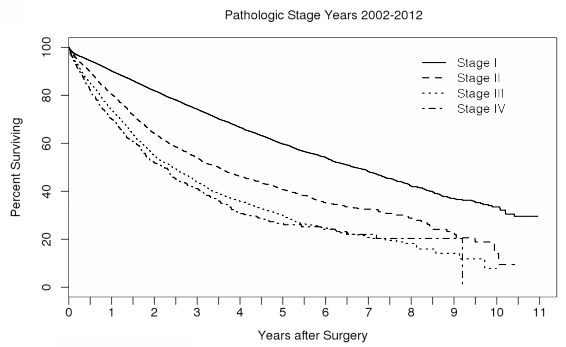To accompany our recent article on minimally invasive lung surgery for Winship magazine, please find a video featuring thoracic surgeon Manu Sancheti, MD.
As Sancheti explains, an advantage of minimally invasive approaches (sometimes called VATS for video-assisted thoracic surgery) is that surgeons do not open the patient’s chest, avoiding pain and potential complications and reducing length of stay in the hospital.
Among thoracic surgeons, the shift to this type of approach has taken place in the last few years — unevenly. Here’s a graph fro m one recent publication from Felix Fernandez, MD and colleagues, showing the percent of stage I lung cancer surgeries — compiled for individual surgeons in the Society of Thoracic Surgeons — that are minimally invasive from 2011-2014. The average is about 63 percent, but it varies widely.
m one recent publication from Felix Fernandez, MD and colleagues, showing the percent of stage I lung cancer surgeries — compiled for individual surgeons in the Society of Thoracic Surgeons — that are minimally invasive from 2011-2014. The average is about 63 percent, but it varies widely.
Attention medical journalists: if you want to ask questions like “Are these minimally invasive lung surgery approaches really good for long term patient outcomes?”, Fernandez is your guy. As the numbers come in, he is leading a team that is analyzing them.
For example, an important question is whether minimally invasive approaches are just as good for detecting whether lung cancer has spread beyond its site of origin. Another recent paper from Fernandez, surgery resident Rachel Medbery and colleagues showed that “nodal upstaging” — discovery of cancer in the lymph nodes, indicating that the cancer has spread — is slightly more likely (14 vs 12 percent) with a open rather than minimally invasive approach. The difference was smaller for academic/research hospitals, and the data for this analysis came from procedures performed 2010-2011; so stay tuned.
If lung cancer is indeed “pathological stage I“, there is a considerable survival advantage, as can be seen in this recent paper from Fernandez combining Society of Thoracic Surgeons data with CMS data on patients aged 65 and older. Median survival after lung cancer resection was 6.7 years for pathologic stage I, 3.5 years for stage II, 2.4 years for stage III, and 2.2 years for stage IV. This paper didn’t separate out minimally invasive approaches, but future analysis will, the authors say.

